Landing your next job rests on getting the hiring manager’s attention in seconds.
Think of this as your opportunity to speak directly to them and make a case for you being the perfect candidate. You only get one chance to make the right first impression.
A well-positioned cover letter can turn the hiring manager’s head and make you a memorable applicant. So, how do you get it right? We explore how to write a cover letter, what to include in each section, and what you can learn from our prime examples.
Let’s get down to it and find out how to write a cover letter that lands you an interview.
What is a cover letter?
Also known as an application letter, a cover letter is a short message you send directly to the hiring manager. This letter accompanies your resume, offering supplementary evidence about why you’re the right candidate for this vacancy.
A typical cover letter is only three to four paragraphs long. For that reason, you need to be selective about what you include in this document. Every sentence must add real value to your overall application.
Before we take a look at how to get started, check out our cover letter example:
Pick a cover letter template
Ready to get started? The decision you need to make is which cover letter template to use. We offer a wide selection of simple, modern, creative, and professional templates you can edit.
Here’s a quick breakdown of what each template style offers:
Simple
Perfectly balancing a functional yet attractive design, our simple resume templates suit a wide range of professions. If you’re looking for a clean and crisp style cover letter, look no further.
Creative
If you want to showcase your unique personality, opting for a creative cover letter template may be the answer. Featuring creative flourishes and plenty of color, you can't go wrong here.
Professional
Aiming for that top job? You need a cover letter that conveys your professionalism and experience level. Using a field-tested professional cover letter template is the way to go.
If you prefer editing in a specific software format, choose one of our Google Docs or Microsoft Word cover letter templates.
Cover letter structure (what to include)
The first step in perfecting this art is understanding what elements to include. While each cover letter is different, they all have the same structure as follows:
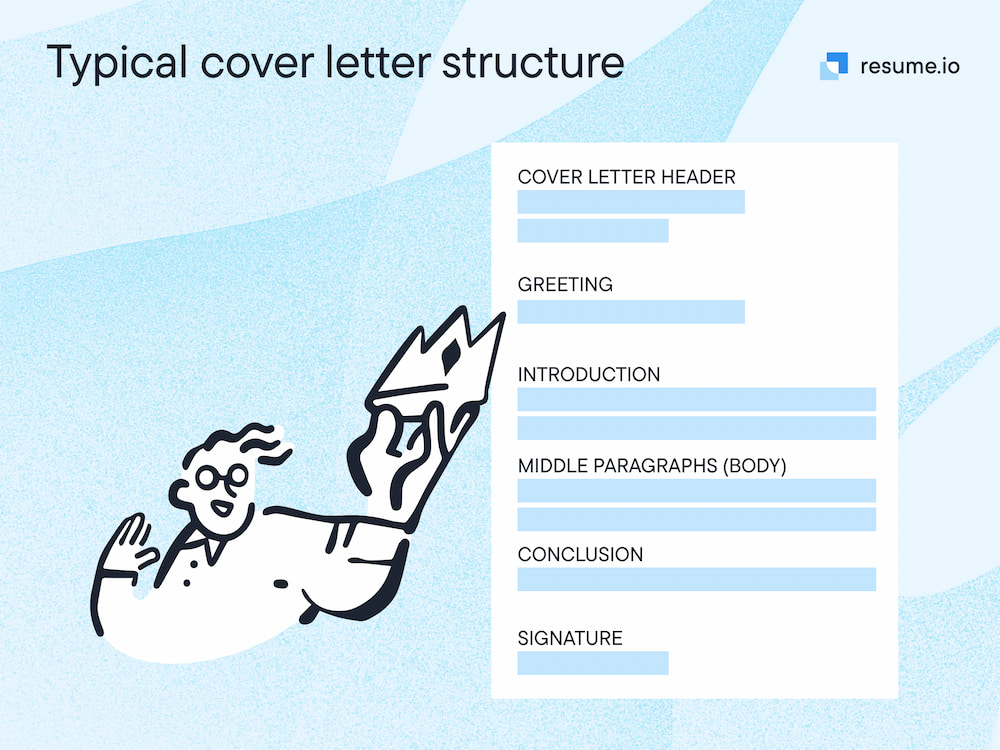
- Cover letter header. Start by including your full name, phone number, address, email address, and LinkedIn profile (if applicable) at the top of the page.
- Greeting. Find out who the cover letter should be addressed to and use their name. Alternatively, you can address your cover letter to the team or department.
- Introduction. Kick things off with an introductory paragraph that packs a real punch. Include your unique selling proposition (USP), if possible.
- Middle paragraphs (body). Within the next two or three paragraphs, highlight your accomplishments, skills, and personality. Try to add as much context as you can.
- Conclusion. Add a Call to Action (CTA) at the end of your cover letter. You should also reaffirm your enthusiasm for the job opening.
- Signature. Finally, end your cover letter with a professional sign-off, such as ‘Sincerely’ or ‘Kind regards’ and your full name. Never add a P.S. at the end of this letter.
Always do your research first!
Before writing your cover letter, research the company, the position, and the hiring manager. Use any information you gain to guide the body content of this letter. This approach will give you a competitive edge and show the reader you’re serious about the vacancy.
Step #1: The cover letter header

Now that you’ve chosen your cover letter template, it’s time to work on the content. The first section you need to tackle is your cover letter header.
Here’s how the section should look:

The header includes your personal details—your full name, the job title you’re aiming for, your address (i.e. location), your email address, and your phone number.
It doesn’t end there. You should also include the name of the company you’re applying to work at and the name of the hiring manager, or whoever you’re addressing the letter to.
[Your Full Name]
[Your Location] | [Your Phone Number] | [Your Email Address]
[LinkedIn Profile] (optional)
[Company Name]
[Hiring Manager's Name]
[Company Address]
[Date]
When using our simple cover letter builder, you will see the above fields.
Simply fill them out, and the tool will create the header for you.

Step #2: The greeting/salutation
Next up, it’s time to say hello to the reader. Before you get started, you should research the hiring manager. Often enough, the job advert will include the name of this person. However, if that is not the case, you may have to do some detective work and look on LinkedIn.
Keep things simple and professional by using “Dear” and the hiring manager’s title and last name. For example, you might write “Dear Mr. Jones.” Avoid using the hiring manager’s first name, as this can sound too casual. Check out the below to see how to get it right:
Dear Mr. Smith
Hey Sam,
If—after you’ve done your research—you can’t figure out who the hiring manager is, don’t panic. You can use the department name or team name instead. For example, you could write
“Dear marketing department” or even “Dear marketing manager”.
Never use “ To Whom It May Concern”
Back in school, you were taught to use “To Whom It May Concern” when writing formal letters. However, this rule is outdated now and makes you look out of touch.
When you’re writing your cover letter, avoid using this tired phrase and opt for one of the suggestions we’ve made.
Step #3: The cover letter intro
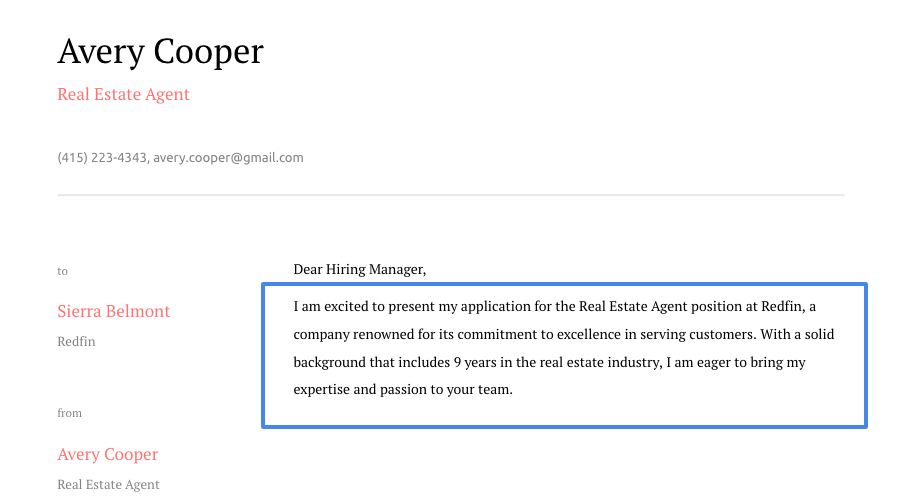
Next up, it’s time to get the reader’s attention. It’s important to start strong so that the hiring manager reads on. For that reason, you need a powerful ‘hook’ at the start of this letter.
Consider what your most high-value attribute is, and go with that. This cover letter section is all about standing out from the crowd and making an impact. You might want to lead with your greatest accomplishment, a hefty statistic, or an anecdote that makes you unique.
The approach you choose depends on your career history, experience level, and the impression you want to make. Below, we’ve outlined a selection of copyable examples for inspiration.
Example 1: lead with a statistic
Dear Mr. Garmin,
As a driven professional in the top 3% of salespeople at Peter Matthews, I have consistently exceeded the expectations of the senior leadership team. I am now looking to take the next step in my career and would relish the opportunity to join the ranks at Vintage Motors.
Example 2: start with an anecdote
Dear Mr. Smith,
When I was just 12 years old, my mother took me to the Museum of Modern Art in New York City. The two of us marveled at the majesty of the artwork on display and talked for hours afterward about a particular piece that stood out. I knew then that I wanted to work in the creative field facilitating that formative experience for generations to come. It was for that reason that I first decided to pursue the competitive role of curator.
Example 3: add a personal touch
Dear Mrs. Wiser,
First of all, it was a pleasure to meet you recently at the annual Women in Marketing Conference. I was inspired by your talk on the power of clear leadership in modern marketing and wanted to commend you on delivering a unique perspective on this issue. I was, therefore, thrilled to see that you’re advertising a new vacancy at Pink Cat Co. and would love the chance to be considered.
Example 4: include your goals
Dear Mrs. Samson,
As a recent social research graduate with experience in the health sector, it’s my goal to work on innovative projects that have an impact and reimagine modern healthcare services. Over the years, I’ve been immensely impressed by the work of Jenkins Ltd. and would relish the opportunity to hone my skills and develop under your steady leadership.
Step #4: The middle paragraphs (body of the letter)
Your intro piques the reader’s interest. Now that you’ve got them hooked, it’s time to elaborate on your skills, experience, and what makes you right for this job.
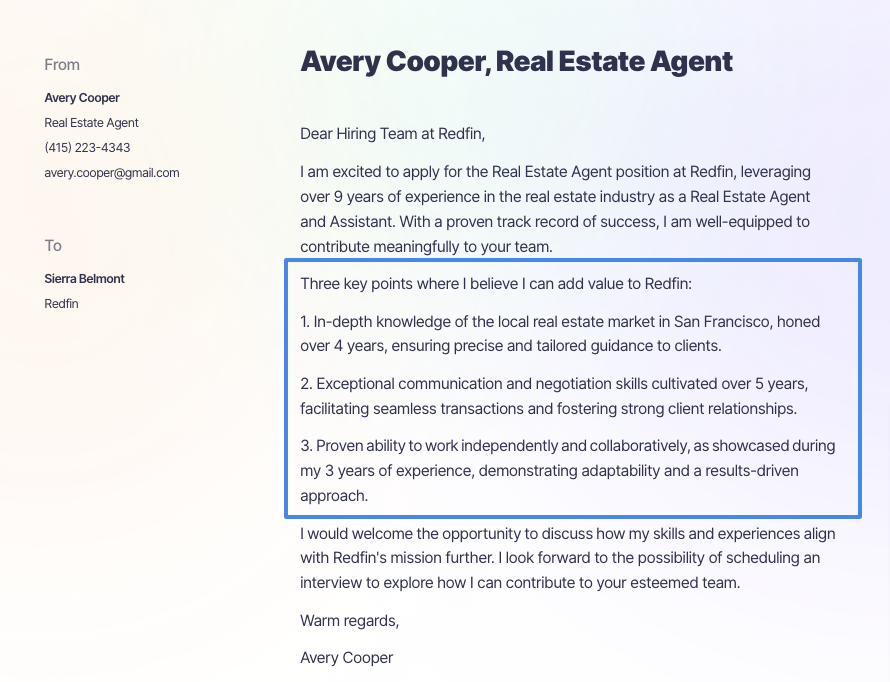
The middle paragraphs of your cover letter need to follow a clear narrative. Each section should build on the last, creating a clear picture of why you’re the perfect candidate for the position.
There are plenty of angles you can use to position yourself well here. Let’s take a look at some of the core elements that you may choose to include in this part of your cover letter:
- Education. If you’ve not already done so in your introduction, include a mention of your education. Elaborate on why this experience prepared you for the industry at hand.
- Skills and experience. Add contextual references to the skills and experience you have under your belt. Emphasize how you’ve used these within a workplace setting.
- Sector knowledge. What special knowledge do you have in this sector, and how do you stay up-to-date? Make it clear that you have your finger on the pulse.
- Work ethic and approach. Don’t merely focus on what you do, but how you do it. What is your work ethic like and how do you approach the tasks of your job?
- Additional experience. Do you have any experience outside the workplace that has prepared you for this role? Add in any anecdotal experiences that add value here.
- Goals and aspirations. Where do you see yourself in the future, and how does this position fit into that image? Show the hiring manager you’re in it for the long haul.
- Company alignment. Why are you applying for this specific job? Research the business and show how your expertise aligns with the demands of the company.
You don’t have to include all of the above. Think of this as a menu—you can select any parts that suit your application. Let’s take a look at a copyable example below:
Over the last seven years at Irwin Finance, I’ve consistently over-delivered, exceeding my KPIs. I have a track record of 98% customer retention and pride myself on building lasting relationships with clients. I’ve previously been commended on my approachable and persuasive sales approach, which allows me to deeply understand customer needs and provide them with packages that suit their long-term financial goals.
Two years ago, my manager recommended a learning and development scheme to further my leadership skills. Having recognized my innate ability to share knowledge with the team, he was eager for me to formalize this skill set. Upon completing the 180-hour course, I was promoted to the position of sales supervisor and have since flourished in this role.
While my experience at Irwin Finance has proved both educational and inspiring, I have reached the highest position in this company. As such, I am now looking for a role in which I can continue to develop my talents and climb the career ladder. I understand that Taylor and Taylor is an international finance business under which I would have the chance to thrive.
Try to make a compelling case as to why you’re ideal for this position. Avoid including any ‘fluff’ or sentences that don’t add to your application overall.
Step #5: The ending paragraph of your cover letter (conclusion and call-to-action)
End on a high with a closing paragraph that reaffirms your suitability for the position. The aim of the game is to stand out and increase your chances of landing that interview.

Writing a persuasive conclusion is challenging. You need to leave the right impression on the hiring manager. Consider how you can elevate yourself above the competition. Here are three of the approaches you might choose to take when writing your closing paragraph.
- Make a connection: Explain why it is that you want to work at this specific company and align your long-term goals with the position you’re applying for.
- Focus on the employer: Put yourself in the employer’s shoes and speak to what they need in order to fill this position. Tell them what you have to offer quickly and concisely.
- Start a story: Lastly, you might use the less traditional approach. That is to tell a story illustrating your achievements that you can continue to tell at an interview.
Include a Call to Action (CTA)!
When you have completed your closing paragraph, add a Call to Action (CTA) into the mix. This sentence encourages the hiring manager to reach out to you immediately. You can even include your phone number at this point.
Ensure the tone is clear and optimistic, but not overly confident or presumptuous. You don’t want to come across as if you believe you have a right to the job. Be mindful of this.
To help inspire you when you’re writing your cover letter conclusion, take a look at our example:
Should we have the opportunity to speak further at an interview, I would love to elaborate on my tried and tested sales technique. I believe that this unique approach has helped me to exceed quarterly targets by at least 14% year on year. The strategy proved so popular that I was advised to teach the rest of the sales team how to implement it for themselves.
Step #6: The sign-off
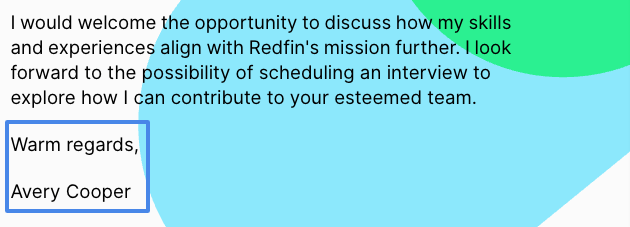
When you’re happy with the content of your cover letter, there’s only one thing left: the sign-off.
Your cover letter signature can be straightforward. Start by choosing a formal approach, such as “Kind regards,” “Regards,” and “Best regards.” These sign-offs sound professional. As a general rule, you want to avoid anything too casual, such as “Thanks” or “Yours” here.
You should then add your full name below. Make sure that this is exactly the same as it’s listed on your resume.
For example, you might write “Maria Smith” or “Maria E. Smith,” depending on what it says on your other documents. Don’t make the mistake of using nicknames.
Best regards,
Micheal Simons
Thanks,
Mickey
How to make a cover letter with no experience
When you lack experience in the industry you’re applying to, your cover letter plays an important role. Use this letter to assure the hiring manager that your inexperience won’t be a problem.
Of course, you can’t talk about your experience in your cover letter, since you don’t have any. With that in mind, you need to think of other ways to impress the hiring manager.
Here are some examples of what you may include in your no-experience cover letter:
- Enthusiasm for the industry. Whether you’re a recent graduate or a career-changer, take the chance to explain why you want to enter this industry. Explain what your driving force is, what you hope to achieve, and how this position fits into this plan.
- Your career plans. Since you are new to the field, chances are you have some pretty epic plans in mind. Why not share them with the hiring manager? Show that you have ambition and that there’s a clear reason for you applying to this position.
- Voluntary experience. Do you have any voluntary experience that aligns with the industry? For example, if you’re applying for a teaching position, you might have experience of working at a summer camp for children. Outline the experiences you have and, where possible, draw direct comparisons to the job you’re applying for.
- Projects and assignments. This one is particularly important if you’re a recent graduate. Did you complete any projects during your studies that have equipped you with the skills you’ll need for this role? For example, if you’re applying for a marketing role, you might have completed a business module on branding a startup company. Elaborate on this project and explain how you went about completing it.
- Clubs, activities, and extracurriculars. Finally, are you a member of any clubs or societies? If so, you might want to draw upon this experience to showcase certain skills that the role will demand. For instance, if you were captain of your college football team, you could use this to illustrate your leadership abilities. That will work when you’re applying for a position in which you will be responsible for other team members.
Lacking experience can feel intimidating—especially when you’re up against a whole host of qualified candidates. Take the time to write a cover letter that shows your talents and skills.
Remember that everyone has to start somewhere, and you’re no different!
Use AI or ChatGPT to write your cover letter
AI is taking over the world. But can it help you to write your cover letter? The short answer is yes. However, you need to be careful when using ChatGPT or other AI systems.
The truth is that ChatGPT can make mistakes. It lacks context and can only work with the information that you give it. For that reason, you need to take the lead. Rather than allowing the software to do all of the work, think of AI as an assistant, helping you along the way.
Here are some of the ways you can use it to supercharge your letter with AI.
Tailor your cover letter to the job description
The perfect cover letter is tailored to the demands of the job description. Our cover letter builder boasts a powerful AI feature to help you write the perfect cover letter and land that interview. Write the content of your cover letter first, and then use the feature to optimize it in seconds.
- Create or upload your resume: Start by either creating a new resume or uploading an existing one within the builder.
- Provide the job description: Share the job description by pasting the text or providing the URL.
- Generate your cover letter: Go to the resume section and click “Generate.” This will create a tailored cover letter for you, incorporating relevant references and keywords from the job description.
View an example of how it works:
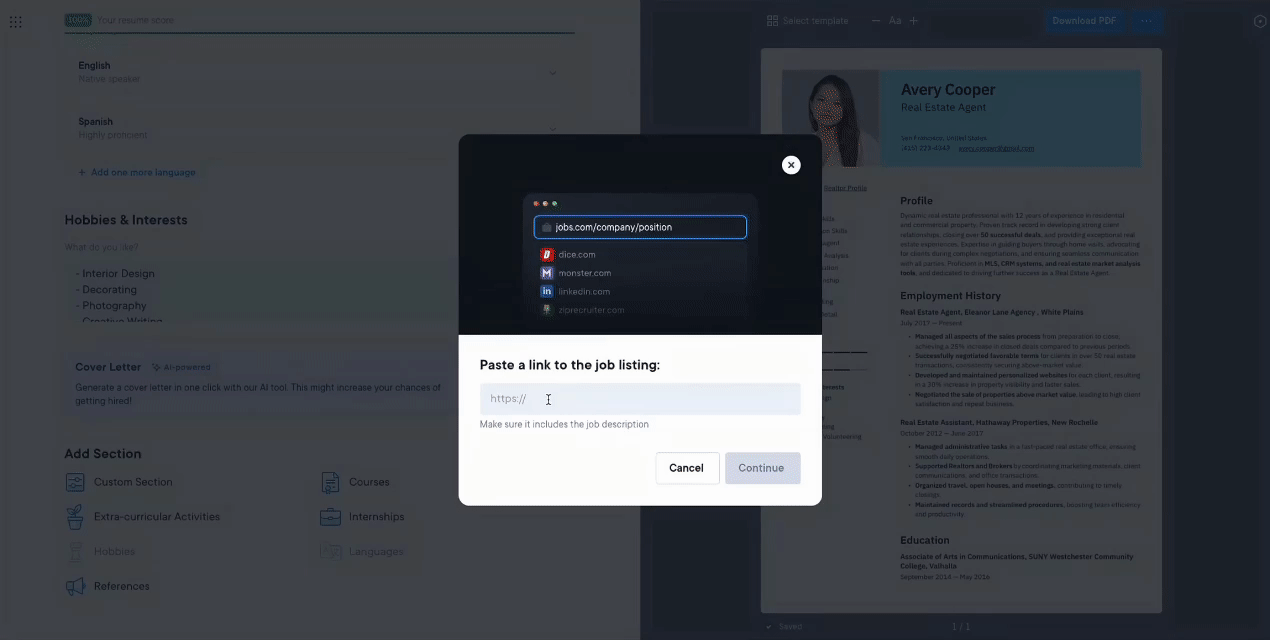
Be sure to check the cover letter after you’ve used this feature. You should tweak the generated content to make sure that it’s 100% accurate and aligns with the experience you have.
Use ChatGPT to outline your cover letter
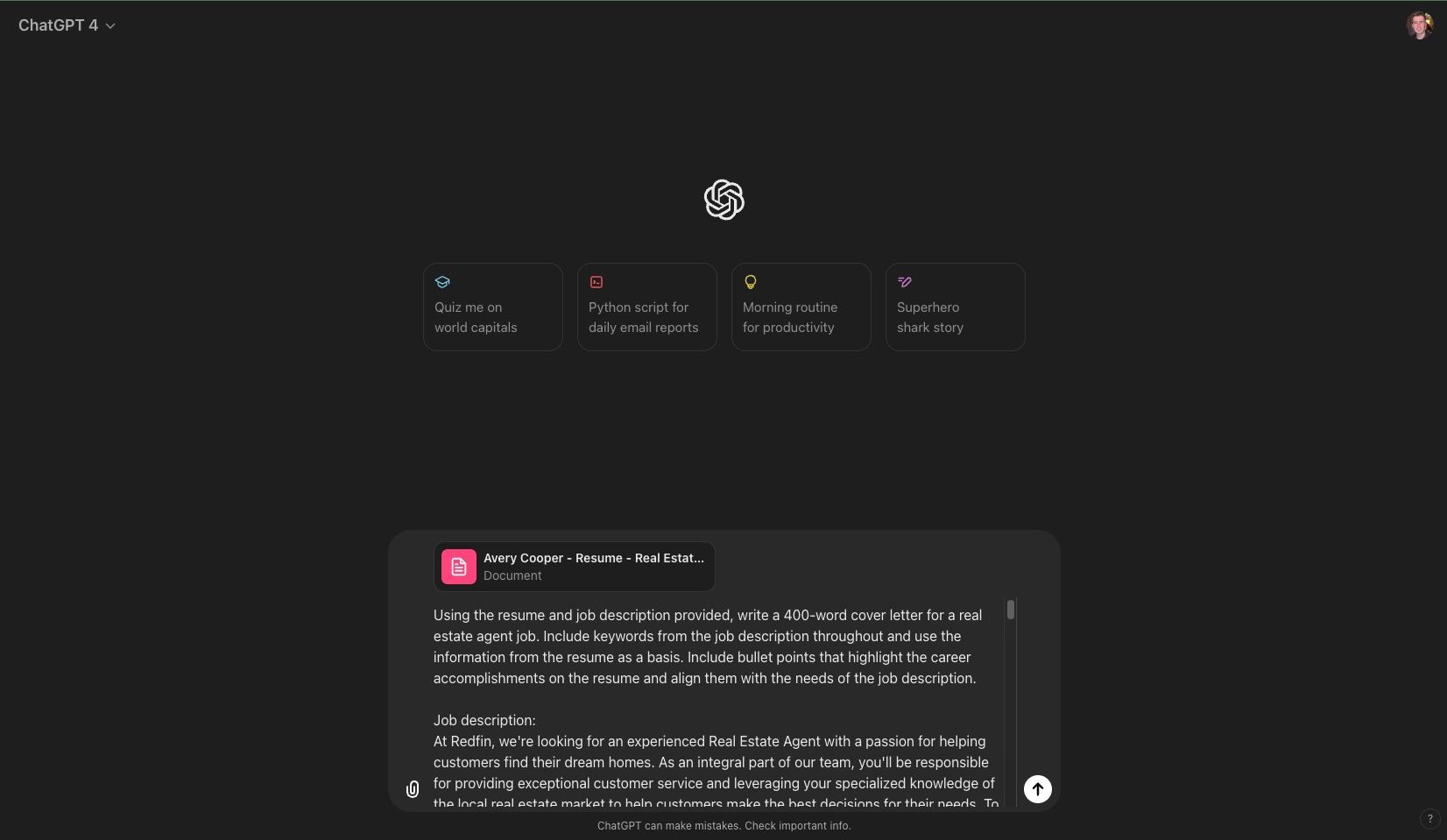
While our cover letter generator should provide the best and most detailed output, you can also use ChatGPT to help you get started.
First up, you need to give it information to work with. You can upload your resume and the job description for the position. Next, you need to prompt the AI software to create a cover letter outline.
Use a prompt such as: “Using the resume and job description provided, write a 400-word cover letter for a real estate job. Include keywords from the job description throughout and use the information from the resume as a basis. Include bullet points that highlight the career accomplishments on the resume and align them with the needs of the job description.”
Chances are that ChatGPT will deliver a well-written cover letter that you can use as an outline. However, don’t simply copy and paste the AI-generated letter (as seen below).
Doing so is a dangerous game to play. Instead, go through the letter and edit it to make it sound more human. You should also look out for any inaccurate or irrelevant information. There’s power in knowing what to delete.
AI-generated content often contains tell-tale signs, such as overly polished or excessively detailed cover letters, and HR professionals now have access to sophisticated tools that easily identify such content.
Optimize your cover letter for the ATS software
The vast majority of employers now use applicant tracking software (ATS) to review incoming applications. The programs rank applicants by how well they meet the criteria of the role—which is most often outlined clearly in the original job description. Only the applications that score the highest within the program will pass the test and get seen by the hiring manager.
If you want to make sure that your cover letter beats the bots, you need to optimize it for the ATS. You can do this by using keywords and phrases found in the original job advert.
Go back to the ad to see which words are used. Peppering your cover letter (not to mention your resume!) with these keywords could increase your chance of landing an interview.
For example, the original job description may include the following keywords:
- “Marketing manager”
- “SEO and PPC knowledge”
- “Copywriting skills”
- “10 years of experience”
In that case, you can mention these words in your cover letter. Note: You need to use the exact same phrases (not synonyms) to help your letter get past the ATS.
Using the above keywords, an optimized cover letter may include the following sentences:
“As a senior marketing manager with more than 10 years of experience, I am excited at the prospect of joining Yellow Cat Agency. Over the years, I’ve honed my excellent copywriting skills, collaborating on big name advertising campaigns. Additionally, I boast a selection of digital marketing skills, such as in-depth SEO and PPC knowledge.”
Make sure you're hitting every keyword that you’ve highlighted from the job description. This approach may help your cover letter to breeze past the bots while also impressing the reader.
Classic cover letter mistakes
We’ve detailed how to write a cover letter and served up some adaptable examples. But what about what you shouldn’t be doing?
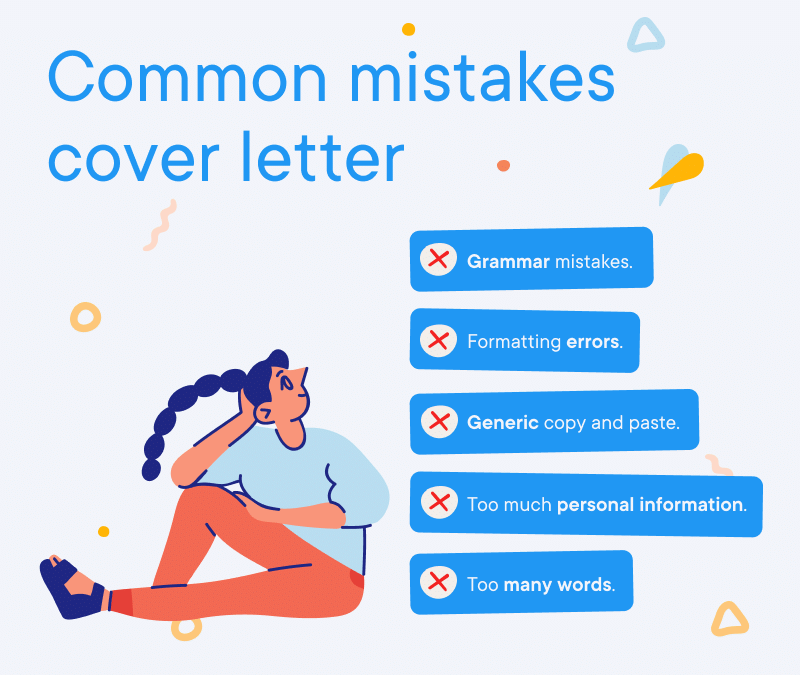
Before you finalize your cover letter, there are some common mistakes that you may have made. Here are the ones you want to avoid:
- Spelling and grammar mistakes. You might have dazzled the hiring manager with your cover letter, but one spelling or grammar error can change everything. While this may sound like a minor problem, leaving these in your cover letter shows you lack attention to detail. Always proofread your cover letter and use software, such as Grammarly, too.
- Formatting problems. Whether the header and body are too close together or the font size varies, these formatting issues stick out like a sore thumb. Everything about your cover letter format should scream professionalism. That leaves no margin for error. By using our field-tested cover letter templates, you don’t have to worry about this problem.
- Generic copy and paste. Generic cover letters will get you nowhere fast. If you’re using the same cover letter for every application, you could be ruining your chances of landing an interview. Instead, tailor your cover letter to align with the vacancy and the company. Edit your cover letter so that it is unique to the position that you are applying for.
- Too much personal information. You’re writing a cover letter, not a dating profile. The hiring manager does not need to know that you have a good sense of humor or what your first pet was called. If you’re getting too personal in this letter, it can be off-putting. Stick to your professional attributes, achievements, and goals, wherever possible.
- Too many words. The hiring manager doesn’t have time to read a memoir. As a general rule, your cover letter should be no longer than 400 words and needs to fit on one A4 page. If you have a tendency to over-write, don’t panic. You can always edit your content. When you’re finished, go back and take out anything that doesn’t add value.
Cover letter writing checklist
Think you’ve mastered how to write a cover letter? We all forget things from time to time. Make sure that you’ve remembered the following things ahead of submitting your letter:
- Kick things off with a “hook”. You need to give the hiring manager a reason to care about your application. Starting strong with a “hook” is a great way to do that.
- Use powerful language. The words you use matter. When writing your cover letter, make sure that you’ve included dynamic, powerful words throughout. Including specific keywords in your cover letter could increase your chances of getting an interview.
- Tailor your cover letter to the role. Always tailor your cover letter to the company and role. Do your research by Googling the business and looking on its LinkedIn. The more information you can find out about the company, the better you can adapt your letter.
- Include results-based points. When a lawyer makes their case, they provide evidence to back up their claims. You need to do the same. Whenever you make a statement, try to use a results-based point to back it up. That means adding in a statistic or fact that proves how your professional actions resulted in positive outcomes.
- Elaborate on your successes. You’ve already outlined your accomplishments in your resume. However, you can use your cover letter to elaborate and contextualize these feats. Illustrate how you achieved these things and the talents you employed to do so.
- End on a high. Toward the end of your cover letter, keep the energy high and stay positive. Include a Call to Action (CTA) here to encourage the reader to contact you.
While your cover letter is short and sweet, it has a serious job to do when you’re applying for roles. Make sure it ticks all of the boxes before you send it out into the world.
Name the file correctly!
Your cover letter file name should match your resume file name. Use a simple format, such as your name, an underscore, and the words “cover letter”. For example, you might write “dansmith_coverletter” when saving the file.
Cover letter examples
Don’t sit around waiting for inspiration to strike. Take a look at our wide selection of field-tested cover letter examples.
Here are our top picks:
Nurse cover letter example
Nurses play a vital role in keeping patients safe and aiding their recovery. Show off your compassionate side by writing a heartfelt cover letter.
If you have a specialism, illustrate it clearly in this letter and add evidence of your expertise.
Dear Dr. Rowntree,
I write to express an interest in your accelerated nurse midwifery programme for recently-qualified CNMs. During my seven-year nursing career, I have always sought to learn from the best, and there is no better place than at Mount Bisai.
After graduating with a BSN from NYU Rory Meyers College of Nursing I worked as a licensed RN for four years and then decided to take my Masters in Nurse Midwifery. I passed my CNM two years ago, and as a relatively recent Certified Nurse Midwife, I am conscious that the learning process has now firmly moved into the delivery room.
A broad range of experience from prenatal to delivery and postpartum care ensures that I can make a difference in terms of caring for my patients’ needs. I have worked with obstetricians on 150+ complicated cases and while I have a firm grounding in high-risk conditions, I am keen to take on more theory and practice at Mount Sinai. I was commended for lowest rates of C-sections amongst my graduating cohort and I believe that my empathetic interpersonal skills have been vital in offering the highest level of care.
Education is an important aspect of the birthing journey and I strive to take every opportunity to advise around nutrition, exercise, rest and general wellness. Every day matters.
I have 90 letters of recommendation from new parents – many of which focus on how my prenatal efforts have contributed to a sense of calm preparedness when it is time for baby to arrive.
I would welcome a chance to get to know your maternity team and glimpse what I might be like to work with you. I love the job and I want to be the best midwife that I can be.
Yours sincerely,
Jackie Elise
Internship cover letter example
Whether you’ve recently graduated or you’re still in school, an internship provides you with real-world experience.
Be sure to highlight how your education aligns with the role and what you hope to gain from the experience.
Dear Mr. Vince,
I am applying for the internship role in Business Administration at your esteemed organisation.
I am currently in year 2 of a Masters in Business Administration and I'm eager to gain experience, which hopefully would help me to garner a full time position in your company in the future.
The skills I possess would make me an ideal fit for the role, as I'm meticulous with detail, have a can-do positive attitude, and fit in well in different environments.
I enjoy working as part of a team, but I am equally comfortable working on my own initiative.
London Bridge Support Services is a company that I'm excited at the prospect of working for, as you have an outstanding reputation for delivering a quality service to customers. This is shown by the awards you have claimed over the years and your reviews on Glassdoor etc.
My long-term career goals are to work with a company that offers challenges and develops employees, and this internship would help give me the knowledge and experience I need to achieve this.
It would welcome the opportunity to discuss my experience in more detail and, of course, hear more about your organisation.
Regards,
Felicity Kendwell
Admin assistant cover letter example
Successful admin assistants need to juggle multiple tasks and make it look easy. Use your cover letter to share your experience so far and contextualize the skills you already have.
Dear Ms. Woods,
Since my childhood, I have experienced a deep pleasure in keeping every plate spinning.
When a Spike employee requests administrative assistance, they need to know that you will not only complete what they ask, but also do it to the very highest standard. This requires practiced organizational skills, mental agility and a singular focus on tasks. In my five years of admin experience, I have never missed a deadline and always received the best appraisals for quality of work. Admin assistants need to get things done and do them well.
You expect your administrative assistants to be familiar with the latest technology, utilize the most cutting-edge communication methods and organize their time so that they can be of the most use to the most people. My weekly productivity blog has 5,500 subscribers, so the latest thinking and practice is not foreign to me.
Five years of administration experience make me the perfect candidate:
- Exclusive experience in consumer fashion. I know the demands of the industry.
- Work ethic – complete 80-100 individual tasks a day – I just love ticking them off.
- Ambitions to grow. Am about to complete a distance learning business degree.
Busy days put a smile on my face. When tasks are coming at me thick and fast, I don’t let anything drop off the table unless I know that I have done my best. In my role as an administrative assistant, adopting a service-first attitude with all those I work with helps me to make their working days more successful by filling in the gaps.
If I have the skills to do a great job, there is no task that I would not take on. If I don’t possess the skills, I will learn them or ask someone else to help me.
If it sounds like I might be able to make a difference to your Spike family, I would be grateful if you would consider my application. I hope to be a value-added and reliable addition to your administrative team.
Sincerely,
Daniel Murray
Teaching cover letter example
The teaching field is highly competitive. In your cover letter, focus on your teaching practices, career accomplishments, and anecdotes that set you apart from the crowd.
Dear Principal Wilson,
Newton’s first law of motion states that an object will stay at rest until a force acts upon it.
Two decades of seeing 500+ science students graduate from Ivy League universities tells me that my “force” is indeed helping to develop the scientific minds of tomorrow. I hope to bring this experience to the advertised science position at Jefferson High School.
As the subject lead for a district of 18 schools, I facilitated the creation of learning materials and oversaw an improvement of graduation rates by 10% across the district over a four-year period. In my school, the graduation rate averaged 99%. I believe in the power of learning through experiment rather than theory – showing beats telling every time. Innovative approaches often bring new discoveries.
I have been active in creating online lessons for my students and believe that blended learning is the future of education. We might not be with our students as they are doing their homework, but we can send them a recorded online video to explain things. Being able to rewind a video is an amazing way to check understanding.
Jefferson HS values are close to my heart, and it was actually one of your current faculty who suggested that I apply for the role. I look forward to the opportunity of learning more about your staff and students and hope that I might be able to contribute to their success. In the school experiment, every curious young mind matters.
Yours sincerely,
Grace McKenna
Sales cover letter example
Sales is all about clear, open communication. Get straight in there—sharing your top achievements and backing up your claims with results-based points.
Show the hiring manager the value that you bring to the table.
Dear Mr. Hunter,
Delighting a freight customer is about far more than availability and pricing. When competing with my sales manager rivals to sell empty space on a container ship, the basic variables of service and cost are not enough to give me an edge. I need to convince customers that working with them is worth paying for. I sell my colleagues rather than my containers.
As Crano Worldwide is expanding its routes in the Far East, I hope that my B2B sales experience in the region may prove useful. I have networked here for the past decade, speaking at transport conferences, building relationships with 250+ importers and exporters, and doubling market share from 4% to 8% over a six-year period. As a student of the intricacies of the Chinese tender process, I understand how to influence effectively.
Crano encourages a winning mentality at work, and I would fit in well. To demonstrate that I understand the subtleties of selling freight forwarding, consider my track record:
- Increased the ocean freight customer base by an average of 25% over the past five years.
- Averaging 92% annual client retention.
- Increasing annual profit growth per customer by 16%.
- Exceeded annual sales quota by an average of 45% over the last six years.
- 150+ Far Eastern clients — more than half of which could potentially move to Crano.
- Generated $2.3m revenue last fiscal quarter.
- Consistently top in global sales list.
Seeking to understand the precise requirements of each customer is the key to finding those critical negotiation levers and squeezing the potential out of every opportunity. I enjoy the role most when I am managing a fluid sales process rather than simply reacting to leads.
I was referred to this career opportunity by one of your current sales managers, David Grey. I hope for the opportunity of an interview to see why he loves working for you so much.
Sincerely,
Christine Foster
Graduate cover letter example
As you enter the working world, convincing a hiring manager you have what it takes can be tough. Focus on the unique skill set you have and how you plan to use it.
You may also want to include references to your future goals.
Dear Mrs. Lastwell,
As a recently graduated biotechnology major at the University of California, I am excited for the opportunity to work with you at PreGen. My university biotech assignments centered around the food production industry and I firmly believe that technology will help to feed the world of the future.
After leaving with a GPA of 3.8 from Jefferson College, I immersed myself in the academic side of college life. We enjoyed close research links with the local agritech community, and I undertook five separate work placements. I was fascinated by molecular diagnostics and even worked part-time on a project to improve crop yields in Kenya. Your international focus is exactly where the world needs to be focusing its efforts right now.
A junior research associate role with you would provide an ideal starting point. Your track record of developing the brightest of young scientific minds is unmatched in the industry and I yearn to follow in the footsteps of your award-winning agritech magicians.
My education and work experience have combined to give me a solid understanding of laboratory procedures and industry best practice including greenhouse operations and the maintenance of research and chemical application equipment. I saved one work experience employer over $240k by creating a unified operational manual for all employees.
I have spent years immersing myself in the theory of genomics and I look forward to putting my knowledge to use. I enclose a portfolio of my academic research work and have over 20 letters of recommendation from the scientists that I have assisted.
I can’t wait to hear about the potential projects where my contribution may make a difference – an interview to explore the possibilities would be a dream.
Yours sincerely,
Simon Trenton
Software developer cover letter example
Cracking the code and winning over the hiring manager needn’t be hard.
Make sure you’re specific about the projects you’ve completed and the role you played.
Dear Ms. Barnes,
Having worked as a Software Developer for DoIt on the Farm Crossing franchise for the past six years on Old Deaf, Mally Camp, and Flu Horizons, I would relish the challenge of collaborating with your tight-knit team on Blackburst Valley.
I have deep experience in both mobile and console gaming and have played a part in creating the software for some of the most popular mechanics in the game. Working remotely alongside a Japanese software team, I focused on coding the character movement and “reactions” – winning universal plaudits for bringing 400+ villagers to hyper-realistic life.
After receiving my MS in Computer Science from UCLA, I gained software experience in UE4 and Visual Studio as well as fluency in Java, C++, Perl, Python PHP, and ActionScript 3.0. In terms of Blackburst Valley programming, I have done projects in C# and used Visual Studio on a couple of consultancy projects, so although the aesthetics of the two games differ, I possess the programming experience to do the best job.
The following experience would make me a great addition to your Blackburst Valley team:
- Participated in character storyboarding at every stage of game development.
- Developed unique ORM frameworks to dictate how characters interact with tools.
- Created award-winning architecture for dialogue between villagers and character.
I am seeking a move to work with a smaller team as I feel that a flatter hierarchy and simpler decision-making processes would be more rewarding. Great solutions can get buried if they are discussed and amended by too many wise men and women.
I enclose a portfolio of work that I have done over the past five years and would be fascinated to hear how I might fit into your amazing team at a potential interview.
Yours sincerely,
Dale Woodward
Cover letter writing FAQs
Do you really need a cover letter?
Yes, you need a cover letter! This document is your one and only chance to speak directly to the hiring manager. While your resume outlines your skills and experience, your cover letter gives you the space to outline why they matter and add some much-needed context.
How do I start off a cover letter?
Start your cover letter with a strong ‘hook’. This could be your most notable accomplishment, a hard-hitting statistic, or an anecdote. It’s all about getting the hiring manager’s attention.
What is a good sentence for a cover letter?
To create good sentences for your cover letter, use powerful language. Including a selection of action verbs will make your writing more impressive to the hiring manager.
What a cover letter should not include?
Don’t include too many personal details in a cover letter. For instance, you don’t need to include your marital status, whether you have kids, or what your pets are called here.
How to write a cover letter that stands out?
To make sure your cover letter stands out, tailor it to the job advert. By doing your research and adapting this letter, you can easily give yourself a competitive edge.
How to write a short and simple cover letter?
Avoid including “fluff” or unnecessary statements in your cover letter. Whenever you’re considering adding something, question why it matters.
By taking this selective approach, you should have no problem crafting a short and sweet cover letter.

![How to Write a Cover Letter - Expert Guide [2025] How to Write a Cover Letter - Expert Guide [2025]](https://s3.resume.io/cdn-cgi/image/width=420,height=368,fit=cover,quality=70,format=auto/uploads/blog_post/featured_image/314/how_to_write_a_cover_letter_-_featured_image.jpg)















